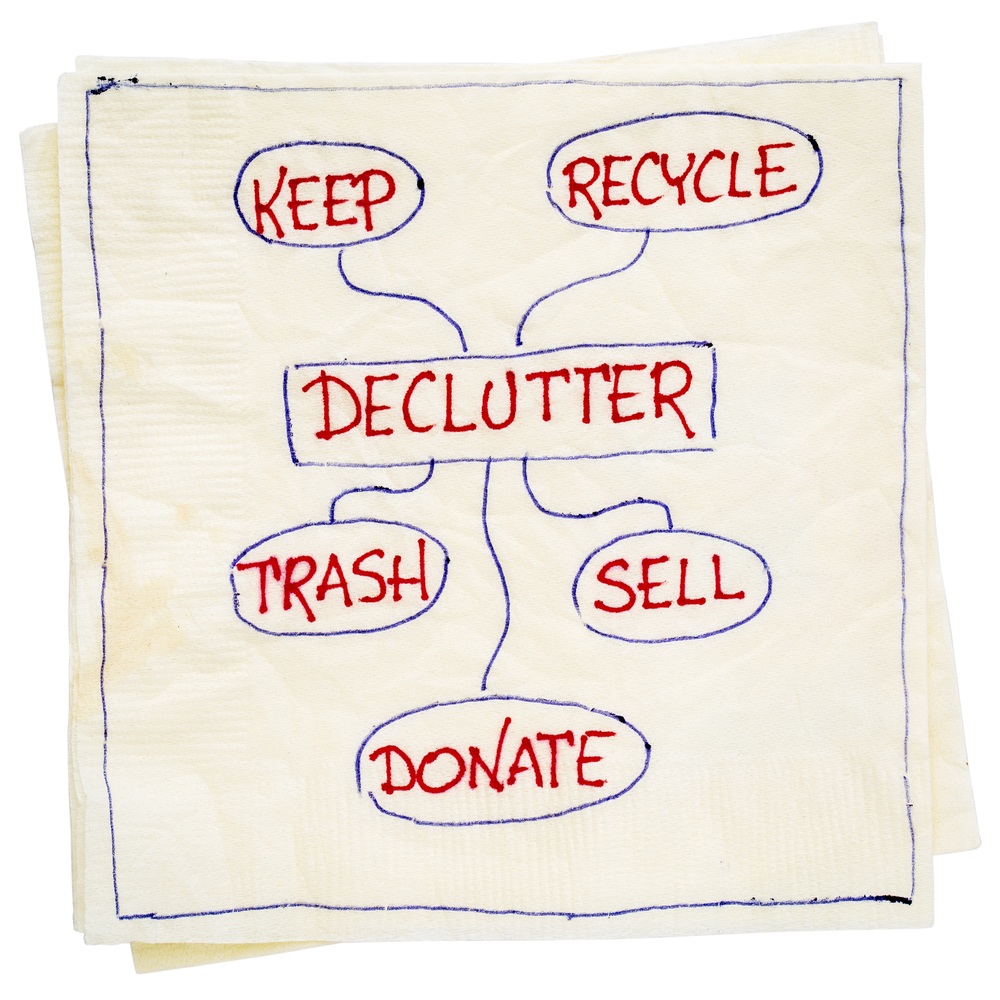The longer you‘ve been in a space, the more time you’ve had to collect things. Some of these things allow you to work more creatively and effectively or simply make your space more appealing to the eye. But sometimes your collection can lead to clutter that causes you to lose efficiency and can stunt the productivity you long for. Most folks have little trouble throwing away things that are clearly broken, but when an item is still good but no longer in service, it can be harder to let go. Add decades in the same space, and your eclectic office may resemble a low-rent rummage sale where there is little room to walk let alone do your job.
Dostadning is a concept from our friends in Sweden that means “death cleaning,” which is the practice of removing unnecessary clutter from your home to make it easier for your loved ones after you pass away. Over time, the term has evolved a bit, and its use has been employed by younger, healthier folks as a way to declutter not only their physical space but to improve their emotional and mental outlook as well. Whereas it may have once been unheard of for anyone below 50 to do any dostadning, adults of all ages engage in it. What works for people, can also work with programs, so this mindset is worth considering for programs of all sizes, be they one room or thousands of square feet, clutter collects easily, especially in our consumer-based society.
When the program I founded purchased its largest location, the space came with a mixed bag of treats, treasures and plain old junk. Previously a farm that had been in the same family since at least 1860, you can bet there were many items set aside for a later date. The family had also rented space to several companies over the years, leaving behind a collection of amazing breadth and depth. Farmers learn not to throw much away as money is tight, repairs are often and ingenuity is king. That old bedframe may be cut and welded onto a broken trailer; that cot may make a great gate for an animal pen. You get the idea.
Our main building was mostly full of items from many lifetimes. Though a bit under 8,000 square feet, in much of the building there was little more than enough room to walk through. A lot of it was junk, but some of the items intrigued us, so we bought the building, all contents included. This meant moving tons of items many, many times as we sorted, remodeled, staged and built. It may have been easier to simply have started with an empty building and then shop  for cool items to furnish it with later, but we wanted an authentic look and felt that nothing would be more authentic than using items that had been here for generations. So we were left with an array of old kerosene lanterns, hand cut nails, old lumber and other antiques to furnish our new offices, but we also had a few thousand square feet of cluttered chaos and new shops and multipurpose areas to build. We had tag sales and hauled away dumpsters full of items until we were left with what we felt was the “good stuff.” However, we simply had far too much of the good stuff to be able to function. That’s where dostadning would save the day — and our programming.
for cool items to furnish it with later, but we wanted an authentic look and felt that nothing would be more authentic than using items that had been here for generations. So we were left with an array of old kerosene lanterns, hand cut nails, old lumber and other antiques to furnish our new offices, but we also had a few thousand square feet of cluttered chaos and new shops and multipurpose areas to build. We had tag sales and hauled away dumpsters full of items until we were left with what we felt was the “good stuff.” However, we simply had far too much of the good stuff to be able to function. That’s where dostadning would save the day — and our programming.
Many of you may have have tried and possibly failed at cleaning out the store room of your own office. On one side you have the coworker who wants to toss everything – from the boxes of old toner cartridges up to and including the ashes of the founder of the program. On the other, you have the coworker who wants to keep everything, including not only the stale donuts in the breakroom but also that box of broken Christmas ornaments that was meant to make the office look more festive but instead caused a trip to the ER for stitches. And in the middle, you have the more level-headed coworkers who want to keep things that are useful and throw the rest away. This works—unless, of course, you have a lot of useful items that you don’t actually use. That’s when you need dostadning the most.
Dostadning embodies the idea that an item can be good but not need to stay with you. Here are some ideas for deciding what to do with the unneeded useful things in your program, home and life:
- Have you used it in the last six months, a year? Do you have clear and solid plans to use it soon (such as seasonal items)? If not, it should probably go.
- Start with the obvious areas –those with the clutter long forgotten– and thus easiest parted with, like storage closets, junk drawers and that old outbuilding that you have not gone into since fuzzy car dice were still a thing.
- Make three piles, one for throw away/recycle, one for keep and one for giveaway/donate. Try to make the “keep” pile the smallest.
- If the space is large, consider getting a dumpster so once you have elected to throw away items they are immediately out of sight. The longer it stays, the bigger the chance that it moves to the saved pile.
- Do try to involve folks that may need items you are getting rid of. Is there a colleague that is just starting out that has a large need but limited funds? If so, ask them to help and to let you know whenever they see things they can use. Knowing an item has a home and a use can make it easier to part with. Just make sure they take it right away, otherwise you may become their de facto storage place.
- Speak with other programs to see if anyone has a posted wish list. If so, offer any of your extra items that are on the list — a great way to help them as you help yourself.
- If you have an empty room, consider moving good but not needed items to it for a time-limited (1-2 weeks) “take what you need” event where you invite the public to come take a look and take whatever they can use (you can include a donation can if you wish in case some folks want to make a monetary donation for an item). When the event is over,
 however, it all goes to a donation center or dumpster — this is about cleaning, not opening a shop.
however, it all goes to a donation center or dumpster — this is about cleaning, not opening a shop. - Use social media to offer items for free (or in some cases, for sale). Programs like Freecycle can prove invaluable but do set firm timelines for pick up.
As you clear away the clutter, you will clear some space—and hopefully, some pressure. By removing items, you may be able to help others as well and also highlight the key items that you kept, transforming a mass of stuff into selectively staged, unique eye-catching displays.
In our case, the dostadning continues. We’re working on our latest dumpster—parting with potential treasures, but clearing up some much-needed space: 1,000 square feet that will soon be 1,600. This space will eventually be a multipurpose room that will host community meals, talent shows, classes and other events. By removing the unneeded, we are bringing new life into once dead space while also lessening the burden on those that will come after us. Death cleaning enables new life and growth, which is what we in the nonprofit sector are all about. I’m rooting for ya.
****
Nonprofit News looks at issues that are of interest to counselor clinicians, with a focus on those who are working in nonprofit settings.

Dr. Warren Corson III
“Doc Warren” Corson III is a counselor, educator, writer and the founder, developer, and clinical and executive director of Community Counseling Centers of Central CT Inc. (www.docwarren.org) and Pillwillop Therapeutic Farm (www.pillwillop.org). Contact him at docwarren@docwarren.org. Additional resources related to nonprofit design, documentation and related information can be found at docwarren.org/supervisionservices/resourcesforclinicians.html.
****
Opinions expressed and statements made in articles appearing on CT Online should not be assumed to represent the opinions of the editors or policies of the American Counseling Association.
